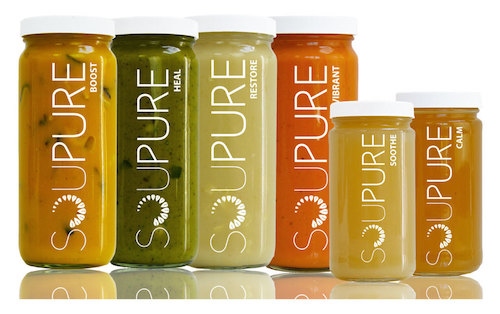What The Hell Is Souping?
The juice cleanse has officially moved from yogi-driven hippie trend to mainstream food offering. Now, even gas stations are offering purportedly fresh-pressed juices, and you can’t throw a carrot without hitting a fashionable new spot selling $10 bottles filled with instant nutrients. Now that we’ve introduced “juicing” into the healthy American diet, though, there’s a new trend that threatens to dethrone the legions of mossy-hued beverages.
If you thought juicing was strange, meet souping. In January, ABC News declared souping to be this year’s “juicing.” The concept is simple — instead of consuming mostly sweetened versions of the kale and carrot and beet concoctions, savory beverages are thrown into the mix, like chicken broth and cauliflower puree. Whether consumed in the bottle or poured into a bowl, though, souping follows the same logic as juicing — you’re still going on a 100% liquid diet.
Soupure, a Los Angeles souping boutique, preaches “nourishment,” not deprivation. Instead of the sterile plastic (or glass, if you’re really dedicated) bottles of juice, soups are beautifully presented in bowls and garnished with (probably organic) microgreens. There are hot and cold and sweet and savory soups, all made with organic, “whole food” ingredients.” Instead of extracting the vegetable pulp away (aka all of the fiber and any remaining nutrients) in a juicer, you’re eating for all the vegetable you paid for, which seems like a better system, right?
If you don’t have the cash to shell out for a fancy juicer or organic vegetable juices shipped from Los Angeles or New York, souping is also great because it can be done at home. Even if you own a juicer, you probably still don’t have any interest in processing dozens of pounds of kale into your liquid five-a-day. Most of the recipes that abound on healthy eating blogs are still pretty sparse — vegetables, broth, and spices, but when you’re trying to prepare for the onslaught of holiday foods, it sounds tempting, right?
Five days of soup sounds infinitely more manageable than five days of choking down a green juice first thing in the morning. But if you’ve ever followed Gwyneth Paltrow’s GOOP cleanse, you probably still have nightmares about the watery soups that promised to “ease inflammation” and “promote detoxification.” Never before have carrots and ginger and leeks been so mistreated. But for folks who have fully accepted that sometimes flavor has to be sacrificed for ultimate cleansing, the appeal of souping makes a lot of sense.
